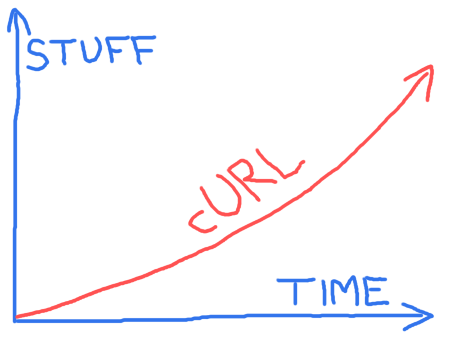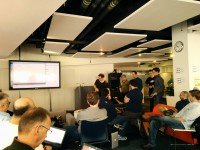 I’m right now working on adding proper multiplexing to libcurl’s HTTP/2 code. So far we’ve only done a single stream per connection and while that works fine and is HTTP/2, applications will still want more when switching to HTTP/2 as the multiplexing part is one of the key components and selling features of the new protocol version.
I’m right now working on adding proper multiplexing to libcurl’s HTTP/2 code. So far we’ve only done a single stream per connection and while that works fine and is HTTP/2, applications will still want more when switching to HTTP/2 as the multiplexing part is one of the key components and selling features of the new protocol version.
Pipelining means multiplexed
As a starting point, I’m using the “enable HTTP pipelining” switch to tell libcurl it should consider multiplexing. It makes libcurl work as before by default. If you use the multi interface and enable pipelining, libcurl will try to re-use established connections and just add streams over them rather than creating new connections. Yes this means that A) you need to use the multi interface to get the full HTTP/2 stuff and B) the curl tool won’t be able to take advantage of it since it doesn’t use the multi interface! (An old outstanding idea is to move the tool to use the multi interface and this would yet another reason why this could be a good idea.)
We still have some decisions to make about how we want libcurl to act by default – especially when we can expect application to use both HTTP/1.1 and HTTP/2 at the same time. Since we don’t know if the server supports HTTP/2 until after a certain point in the negotiation, we need to decide on how to do when we issue N transfers at once to the same server that might speak HTTP/2… Right now, we get the best HTTP/2 behavior by telling libcurl we only want one connection per host but that is probably not ideal for an application that might use a mix of HTTP/1.1 and HTTP/2 servers.
Downsides with abusing pipelining
There are some drawbacks with using that pipelining switch to allow multiplexing since users may very well want HTTP/2 multiplexing but not HTTP/1.1 pipelining since the latter is just riddled with interop problems.
Also, re-using the same options for limited connections to host names etc for both HTTP/1.1 and HTTP/2 may not at all be what real-world applications want or need.
One easy handle, one stream
libcurl API wise, each HTTP/2 stream is its own easy handle. It makes it simple and keeps the API paradigm very much in the same way it works for all the other protocols. It comes very natural for the libcurl application author. If you setup three easy handles, all identifying a resource on the same server and you tell libcurl to use HTTP/2, it makes perfect sense that all these three transfers are made using a single connection.
As multiplexed data means that when reading from the socket, there is data arriving that belongs to other streams than just a single one. So we need to feed the received data into the different “data buckets” for the involved streams. It gives us a little internal challenge: we get easy handles with no socket activity to trigger a read, but there is data to take care of in the incoming buffer. I’ve solved this so far with a special trigger that says that there is data to take care of, that it should make a read anyway that then will get the data from the buffer.
Server push
HTTP/2 supports server push. That’s a stream that gets initiated from the server side without the client specifically asking for it. A resource the server deems likely that the client wants since it asked for a related resource, or similar. My idea is to support server push with the application setting up a transfer with an easy handle and associated options, but the URL would only identify the server so that it knows on which connection it would accept a push, and we will introduce a new option to libcurl that would tell it that this is an easy handle that should be used for the next server pushed stream on this connection.
Of course there are a few outstanding issues with this idea. Possibly we should allow an easy handle to get created when a new stream shows up so that we can better deal with a dynamic number of new streams being pushed.
It’d be great to hear from users who have ideas on how to use server push in a real-world application and how you’d imagine it could be used with libcurl.
Work in progress code
My work in progress code for this drive can be found in two places.
First, I do the libcurl multiplexing development in the separate http2-multiplex branch in the regular curl repo:
https://github.com/bagder/curl/tree/http2-multiplex.
Then, I put all my test setup and test client work in a separate repository just in case you want to keep up and reproduce my testing and experiments:
https://github.com/bagder/curl-http2-dev
Feedback?
All comments, questions, praise or complaints you may have on this are best sent to the curl-library mailing list. If you are planning on doing a HTTP/2 capable applications or otherwise have thoughts or ideas about the API for this, please join in and tell me what you think. It is much better to get the discussions going early and work on different design ideas now before anything is set in stone rather than waiting for us to ship something semi-stable as the closer to an actual release we get, the harder it’ll be to change the API.
Not quite working yet
As I write this, I’m repeatedly doing 99 parallel HTTP/2 streams with no data corruption… But there’s a lot more to be done before I’ll call it a victory.







